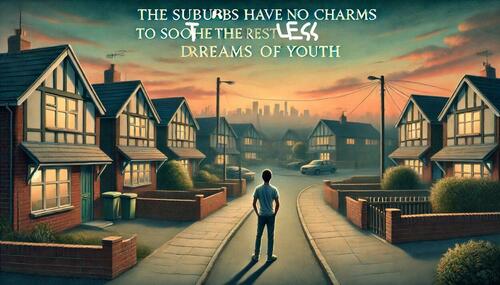We Shouldn't Have To Live Like This

Subdivisions
In their 1982 hit Subdivisions, the progressive rock band Rush lamented that suburbs had "no charms to soothe the restless dreams of youth".
As our friend Kevin Dolan suggests in his guest post below, that's by design. Americans are forced to choose between dangerous cities and sterile suburbs by an aspect of civil rights law called Disparate Impact. The good news, as Kevin notes below, is that Disparate Impact can't continue forever, and there are constructive things you can do in the meantime.
Before we get to Kevin's post, a brief trading update in light of the crash in Hong Kong overnight.
Hong Kong Crashes
Stocks in Hong Kong crashed overnight, with Chinese ADRs following suit today. The proximate cause was a meeting by China’s National Development and Reform Commission, which yielded no additional stimulus announcements. Nevertheless, ZeroHedge expects China will ultimately unleash an even bigger stimulus than it’s last one:
And since for Xi the time for half-measures is now over, especially if he wants to avoid a deflationary spiral, social insurrection and political mutiny, this only leaves one option open: the truly nuclear one. The only question is when, because while the market may have peaked at +30% the first time China tried to goose markets, the next time we are talking triple digits, not to mention $3K gold and $100K+ bitcoin.
We have long positions in Chinese names that should benefit from that nuclear stimulus, including the ones we added yesterday (not the best timing on those, in hindsight). And we have a long position in a unique bitcoin miner, Bit Digital (BTBT), whose CEO we interviewed last week.

Coincidentally, a gold miner hit our top ten names on Monday, so we have an options trade teed up on that for later one today.
If you'd like a heads up when we place it, feel free to subscribe to our trading Substack/occasional email list below.
Now on to Kevin Dolan's insightful post.
Authored by Kevin Dolan at Exit
Disparate impact is the abolition of private property
“Urban planning nerds” love to hate the suburbs.
They’re sterile, isolated, badly constructed, tasteless, expensive, inefficient, car-dependent, etc.
All of this is true — and yet half of Americans choose to live in the suburbs. In particular, something like 85% of American children are growing up in a suburb.
Americans hate commuting intensely — but they spend 4 hours and 40 minutes doing it every week.
Historically and in theory, cities should be the place to be.
Cities are engines of cultural, intellectual, and economic development. Your ancestors accepted backbreaking industrial slavery to escape the isolation of the countryside and access the opportunities and possibilities of life in the city.
It’s way more efficient to bring resources to people than to bring people to resources — virtually all products and services are (or ought to be) cheaper and easier to deliver in cities than in sprawling exurbs.

At the neighborhood level, it makes sense to share amenities, especially expensive stuff that gets intermittent use, like gym equipment and swimming pools — yet the suburbs are packed with nearly-untouched private recreational infrastructure.
Virtually everything that the “interesting right” is working on these days, from homeschool coops to milk shares to preparedness clubs to network states, is an attempt to replicate the network effects and economies of scale that ought to be found in the city.
So why don’t we just move there?
The Urban Planning Nerd explanation for this phenomenon is that Americans are just suicidally tacky.
We’re just so rich and selfish and privileged (and Implicitly Racist) that we prefer to live in isolated McMansions 40 minutes from the office, staging everything we use on our own property so that we never have to share.
The corresponding right-wing caricature of the cities is that they represent a total surrender of personal autonomy — dissociated, inhuman hives in which you own nothing — earning wages from Globocorp to order bug burgers from Globocorp to your pod rented from Globocorp.
Neither of these characterizations is strictly accurate — but Americans in both city and suburb do live in dramatically ugly ways that no one would choose, if they were free to choose.
Why?
Because both city and suburban life are deeply distorted by the abolition of collective property rights.
You do not meaningfully “own” a property if you cannot forbid the public to enter and use it.
In the United States, it is legal to own property privately. You can own a house in the suburbs. The picture is a little more complex for a condo in the city, but you can own that, too, at least in the narrow sense that you’re allowed to have a lock on your door and decide who’s coming to dinner.
What you can’t own is the sidewalk outside your driveway — or the businesses and amenities in your neighborhood, to the extent that these are “public accommodations”.

In other words, a mixed-use neighborhood (containing businesses, cultural venues, and residences) cannot be owned in common by the residents, in the sense that they have no meaningful right to restrict access to the shared property.
The narrowly-construed, for-public-consumption story of the Civil Rights Act was that it was merely meant to prevent explicit discrimination (i.e. “this is a whites-only neighborhood”).
But very early on (starting in 1971, with Griggs v. Duke Power), courts realized that an anti-discrimination statute that only outlawed explicit discrimination was toothless — people who wanted to discriminate could simply find another reason to deny a loan, a lease, a job, etc.
So they came up with the “disparate impact” standard.
“Disparate impact” assumes that human beings are precisely alike across all protected classes, and therefore any statistically significant difference in aggregate outcomes can be regarded as prima facie evidence of illegal discrimination.
Any economic behavior of sufficient scale to allow this kind of analysis must avoid applying any standard which reveals group differences between protected classes — which turns out to be any dimension against which human beings might be measured and compared, any standard of behavior or capacity whatsoever.
The group differences need not be extreme to show up dramatically in the tails, which is where such standards matter most.
Which means that enforcing anti-discrimination with a disparate impact standard doesn’t just require “loosening” of standards to some lower baseline.
The disparate impact standard mandates the total abolition of all categories of distinction.
Even standards that the vast majority of protected individuals would meet, like “being able to touch your toes” or “knowing how to read” or “not stealing everything that isn’t nailed down”.
It doesn’t matter that most minority applicants to the Maryland State Police could touch their toes. The point is that fewer minority applicants could touch their toes — which means that that standard is racist and must be abolished.
This means that, in any space controlled by an institution with more than 15 employees, it is illegal to hold protected individuals to any standard of competence or behavior.
There is no bottom — the only limiting factor is the time and expense required to investigate, test, and dismantle each such standard one by one.
In combination with the nebulous prohibition on creating a “hostile work environment”, disparate impact legally obligates all government and corporate institutions to enforce and propagate this assertion of human equality as a totalizing ideology.
The fact that this ideology is at odds with reality is a feature, not a bug.
It provides the justification for endless revolution — a totally unbounded mandate to regulate and expropriate.
This is a pretty sweet deal for the regulators, and for the most dysfunctional and antisocial members of the protected classes — but it’s a terrible deal for everyone else — including most other protected individuals, because it renders vast regions of the social landscape de facto non-excludable, and thus subject to the tragedy of the commons.

The more your social environment is controlled by government and corporate interests, and the more it is populated by protected individuals, the more the common spaces will suffer from social defection and neglect, and the more the environment will become unsafe, dilapidated, and barren.
If you live and work in a dense urban environment, this describes essentially the entire world beyond your front door.
And if you have zero say in what happens outside your front door, the rot outside inevitably works its way inside. If your packages are constantly getting stolen off the porch and you have to leave your car’s trunk open so thieves won’t smash your windows, it matters less and less what property you technically “own”, in or out of your house.
I’m not totally dismissive of conspiratorial explanations for the phenomenon of anarchotyranny — but we can model the decay of America’s cities, and the legal system’s posture toward “protected” and “unprotected” criminality, without them.
In the suburbs, you still can’t control your street, but you can at least get a lot more private, “ownable” space behind your door — and, more importantly:
It is still legal to discriminate by making your neighborhood expensive.
HOAs and gated communities cannot write covenants governing behavior that will survive contact with a critical mass of protected individuals — but they can simply make the neighborhood prohibitively expensive for protected individuals to move in.
And if they ensure that the neighborhood is nothing but a colossal upscale barracks for commuters, there will be no economic activity that might attract anyone who doesn’t live there.

In other words, the sterility and wastefulness of the suburbs is the point.
It’s a distortionary outgrowth of the abolition of community property, which strongly disincentivizes Americans from investing in, protecting, and enjoying common spaces.
We’d rather bowl alone than live in spaces where we have no recourse against violence and social defection.
This is especially true of Americans with families.
For a young single person, the economic and social advantages of urban network effects clearly outweigh the dangers of life in the city. You can make more money. The social opportunities are a lot more interesting. The food generally is better.
(This is why liberals in Portland and San Francisco love to ostentatiously pretend not to know what you’re talking about when you describe the problems of living there: it’s a flex.)
But when people have kids, they quickly lose their confidence that they can fly above the social dysfunction indefinitely. All sorts of abstract, macro policy problems suddenly don’t feel so abstract.
Regardless of where they live, Americans are forced to spend colossal amounts of psychological and economic resources acting as private security for their kids — which is at least as inefficient and silly as building a private pool in every backyard.
Not only does it exhaust parents, but it prevents kids from developing autonomy, and the physical fitness that naturally comes from running around the neighborhood.
But we shouldn’t have to hover, and we shouldn’t have to run to the suburbs.

The most dynamic heights of the American social landscape haven’t always been for cat ladies and gays. The purpose of ethnic neighborhoods (and ethnic gangs) in American cities was, in part, the provision of a shared cultural and security environment.
The cities could be reordered to accommodate family life — but it would require a restoration of the freedom of association.
Imagine a city in which you could sign up to whatever covenants you wanted. You could have whole blocks of Manhattan as clean and safe as Singapore, with private security dealing with vagrancy and delinquency quickly and efficiently.
You still couldn’t afford a huge condo — because you wouldn’t need to, because you would exercise collective ownership over your entire environment. You’ll Own Everything, and You’ll Be Happy.
If we want people to have kids, we have to create a world in which you can live an aspirational, beautiful adult life alongside your kids.
If your whole adult life is dedicated to helicopter parenting, there’s no space to set them an admirable example. Nobody wants to be a helicopter parent in the suburbs when they grow up.
But if you owned your community, you wouldn’t have to meticulously build your children a boutique social and pedagogical environment, because you would know the character of the adults they would encounter spontaneously. You could trust what they’d learn in the schools, and you could let them have the run of the neighborhood until dinnertime.
This would create the time and space for adult socializing in the community — you could go to a party, go dancing, have a poker night, etc., secure in the knowledge that your kids are “somewhere around here”, but they’re around other good kids and grown-ups, and nothing terrible is happening to them.
Your kids could see in your life an example of complete manhood — not just the recursive example of being a Dad, whose life is all about them.
Until we can build a life like this, we’ll be stuck trying to convince people to breed in captivity, and it will be an uphill battle.
This isn’t the whole story of fertility decline in the West, but it’s clearly part of it. Parenting will never be high-status as long as it is laden with so much unnecessary anxiety and tedium.
This post will be construed to mean that living in a decent place requires state-sponsored segregation — the type of binary that Jon Stewart meant to imply when he said that subways full of vagrants are the “literal price of freedom”.
But it’s actually true that most people, across all categories, are basically decent — they can handle being judged by their conduct and character.
In fact, the restoration of freedom of association would almost certainly increase social integration across class and race, because upper-middle-class people wouldn’t have to blow all their wealth running away from poor people, and members of Protected Classes would no longer be forced to throw in their lot with the most dysfunctional members of their class.
We don’t need segregation — we just need the state to stop tearing society apart hunting for segregationists under the bed.
The good news is that if a trend can’t continue, it won’t.
The competency crisis is coming to a head in all domains of American life. The present system confronts urgent fiscal, security, and demographic cliffs that it cannot survive.
In the meantime, we have to connect the kind of people we want to build with, and take a short position in failing systems. EXIT is a fraternity dedicated to building for what comes next. Join us at exitgroup.us.
If you'd like to stay in touch

You can scan for optimal hedges for individual securities, find our current top ten names, and create hedged portfolios on our website. You can also follow Portfolio Armor on X here, and download our optimal hedging app by clicking on the image below.


